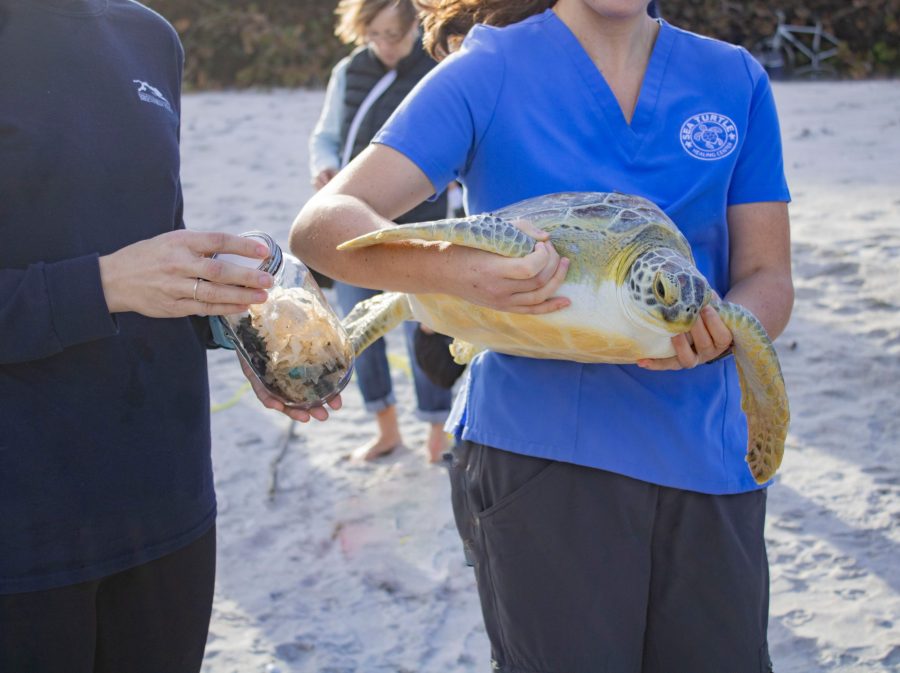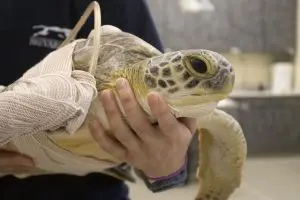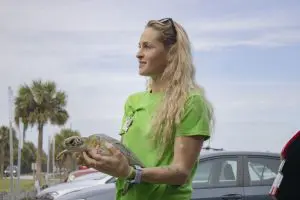

Horchata had eaten loads of plastic from a trash bag thrown overboard a boat.
This month we’re highlighting Plastic Free July as a key way to support our native Florida wildlife, including our iconic sea turtles. Plastic pollution, from the rogue single-use grocery bag to nearly invisible pieces of floating microplastics, is a threat to all the wildlife whose habitats it infiltrates, even humans. Sea turtles are especially vulnerable due to their already declining numbers in their native range (three out of the six sea turtle species are endangered) and the stark effects that plastics have had on their ocean home.
This month, we’re taking a look back at some of our resilient sea turtle patients who have been severely impacted by plastic pollution. Our Healing Center team sees the damage of plastics for sea turtles daily, from derelict fishing gear entanglement cases to ingested plastic causing potentially irreparable harm to their gastrointestinal GI tract. However, there are ways both big and small that we can help change the outcome for our turtle patients and their counterparts in their native range.
Horchata
Picture this: you’re a hungry sea turtle in the open ocean that’s been searching for a tasty meal. You spot a jellyfish nearby – it smells like food and looks like food. However, after a few bites, it’s clear that you’ve made a potentially deadly mistake. Floating plastic bags and other trash grow bacteria after spending time in the water and start to smell like the ocean life sea turtles typically snack on. They can also grow algae or become entangled with seagrass, disguising their identity even further.
Younger sea turtles are especially at risk and will often ingest plastic rubbish after mistaking it for their real food. The consumption of plastic can quickly become a life-threatening emergency. The sharp edge of hard plastics can cause damage to the GI track resulting in conditions like megacolon, an abnormal stretching of the large intestine, or plasticosis, a type of fibrotic scarring caused by ingested plastics inflaming the digestive tract. Softer plastics, like shopping bags, can create a blockage in the intestines. In addition, these plastics take up space in the turtles’ stomach making them feel full, robbing their bodies of vital nutrition.

Horchata was able to be released after a four-month stay!
Horchata the green sea turtle was one of those young sea turtles who had to be rehabilitated after a case of mistaken identity.
Horchata initially came to our Healing Center due to a fishing hook injury. However, it was soon clear that there was something else plaguing this turtle. The day after Horchata’s arrival, there was a significant amount of plastic, likely trash bags, showing up in their stool. Our Healing Center team quickly removed any plastic in the pool to ensure Horchata wouldn’t eat it again. A few days later, the turtle passed even more pieces. An ultrasound was used to evaluate Horchata’s lower GI tract to ensure they didn’t suffer any complications. Luckily, the plastic didn’t cause any untreatable issues in Horchata. However, if Horchata wasn’t rescued for the fishhook injury, the turtle may have suffered further complications from the plastics and may not have been quite as lucky.
After a nearly 4-month-long recovery at our Healing Center, Horchata was able to head back home to the ocean. We were so proud to see Horchata make a full recovery, but not all our patients are so lucky.
Belle
Our Healing Center team has sadly seen many post-hatchings and small juvenile sea turtles pass away after consuming dozens of pieces of plastic. Research says that our tinier turtle friends are the most at risk. When sea turtle hatchlings make it to the ocean, their first stop is the sargassum, a haven of free-floating seaweed that provides a source of food and protection to these younglings. Unfortunately, microplastics have continued to invade the sargassum sea, and it has become extremely common for these young sea turtles to eat the plastics floating amongst their habitats. In a study conducted by the Whitney Laboratory for Marine Bioscience, a shocking 92.86% of washbacks (post-hatchlings that have made it out to sea but are washed back to shore) had plastic fragments in their GI tracts.
Belle was a washback juvenile green turtle who was found stranded with post-hatchlings. Shortly into Belle’s stay with us, our team

Belle sadly passed away from her plastic-related complications.
noticed several pieces of sharp plastic trapped in the turtle’s cloaca, the end of a turtle’s digestive tract. This created a very dangerous situation, as the plastic blocked feces from passing.
Our vet team acted quickly to remove all 14 pieces of plastic. The sharp plastic tore the turtle’s GI and damaged the colon causing permanent damage to the cloaca, and Belle continued to have internal blockages throughout her stay with us.
We took care of Belle for five months; we watched the turtle triple in size and saw their personality shine. However, Belle was diagnosed with megacolon and was going to be unable to heal from this injury. We made the compassionate decision to opt for humane euthanasia, allowing Belle to no longer be in pain. While Belle is no longer with us, we hope sharing this little turtle’s story will inspire people to take action to reduce their plastic consumption.
Gorp
It’s clear that plastic ingestion is a huge danger to sea turtles, but plastic pollution also poses another risk: entanglement. Derelict fishing gear is one of the biggest threats facing sea turtle populations today. Hundreds of sea turtles die annually from plastic entanglement alone. However, Gorp is one turtle who survived the odds.

Gorp is an amputee turtle that returned to the ocean!
Gorp came to our Healing Center in 2023 after being found with fishing line wrapped around their neck, front flippers and back right flipper. Severe trauma was inflicted upon the left front flipper and the rear flipper and both were growing necrotic. While the back one was able to be saved with a fish skin graft and other treatments, the front flipper had to be amputated. Luckily, most sea turtles can live healthy lives with only three flippers!
After two-and-a-half months of intense care from our team, Gorp was released back to the ocean. While we’re incredibly proud of Gorp’s recovery, we also recognize that many of the sea turtle patients that come through our doors with similar injuries don’t share the same miraculous fate.
Luckily, there are a lot of steps that you can take right now to do your part to help sea turtles in their native range. Together, we can reverse these species’ declining populations and help return our sea turtle populations to a healthy size.
Ways to Help
Removing plastic usage from your life can feel like a daunting task, however, simple changes can have big effects:
Need some more inspiration? There are many other ways that you can help out our wildlife populations through reducing your plastic use. Head to www.plasticfreejuly.org to learn more and join in on the challenge!
Have you found a sea turtle that needs help? Visit this page or call the Sea Turtle Preservation Society at 321-206-0646. Want to help the Sea Turtle Healing Center? Support our Zoo, or view our Healing Center’s wishlist.